Family : Labridae

Text © Giuseppe Mazza

English translation by Mario Beltramini
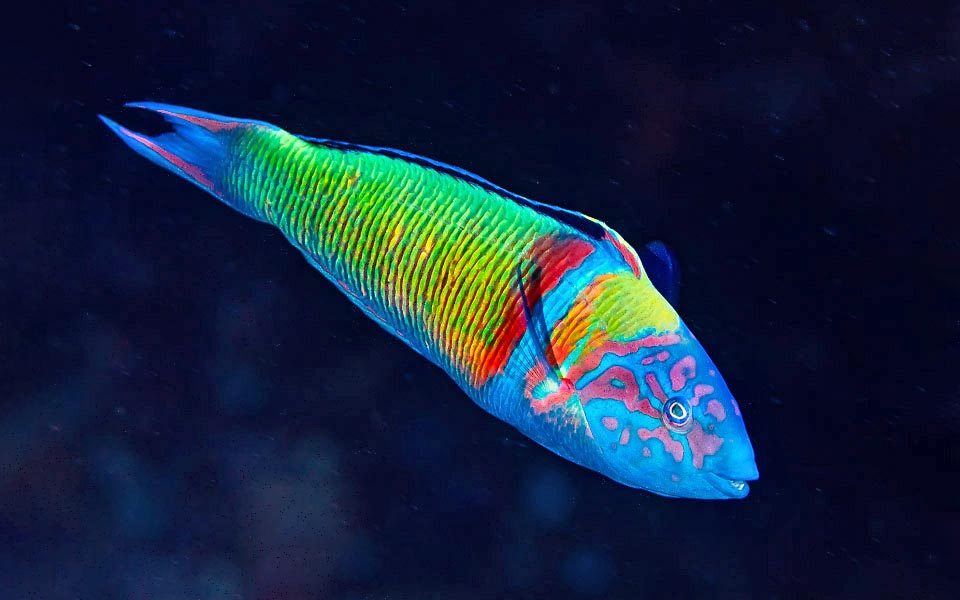
Present also along the Atlantic coast from southern Portugal up to Guinea Fulg, the Ornate wrasse (Thalassoma pavo) is one of the showiest Mediterranean fishes © Raimundo Fernandez
The Ornate wrasse (Thalassoma pavo Linnaeus, 1758) belongs to the class of Actinopterygii, the ray finned fishes, to the order of Perciformes and to the family of Labridae.
The name of the genus Thalassoma comes from the Greek “thalassa”, sea, and “soma”, body; it is therefore an animal having the colour of the sea.
The Latin name of the species pavo, peacock, emphasizes that it is a very beautiful fish.
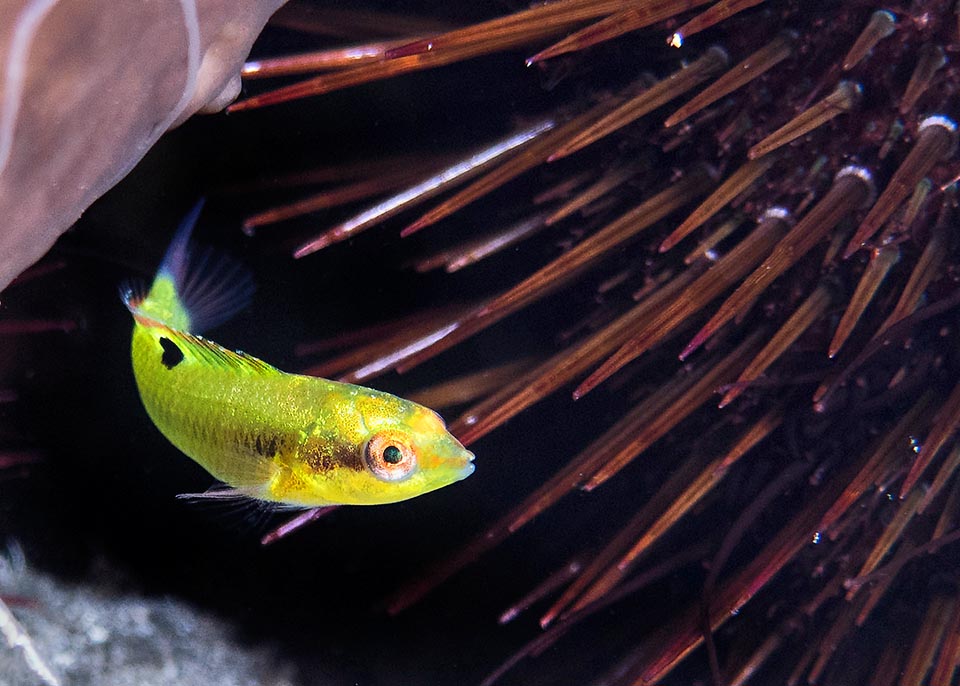
But to reach the above livery, of the amazing terminal male, the way is long and surprising. Initially the juveniles are yellow with a black spot on the back © Rafi Amar
Zoogeography
It is present in the warmest zones of the Mediterranean, but, particularly, along the Atlantic coast from south of Portugal to Gulf of Guinea.
It is found also in several not far away islands, such as the Canary Islands, the Acores, and Madeira.
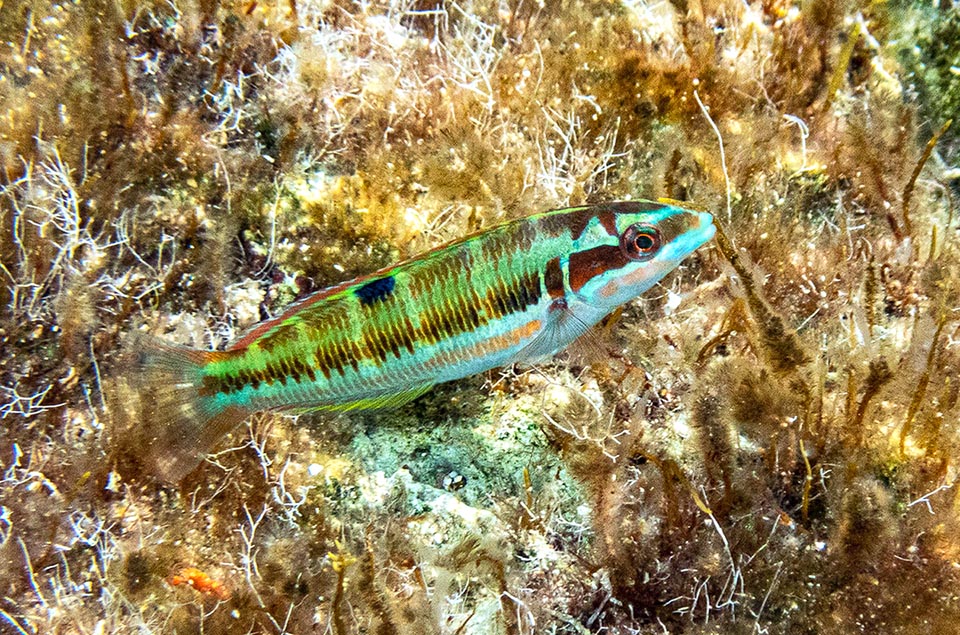
This spot remains also in the following juvenile livery. Here are taking form the 5 characteristic pale bands, but are missing the elegant drawings of head © Stefanos Michael
Ecology-Habitat
Coastal species, we find it on the rocky seabed up to about 20-30 m of depth, but, in some zones, Thalassoma pavo has been sighted even at 100-150 m.
Morpho-physiology
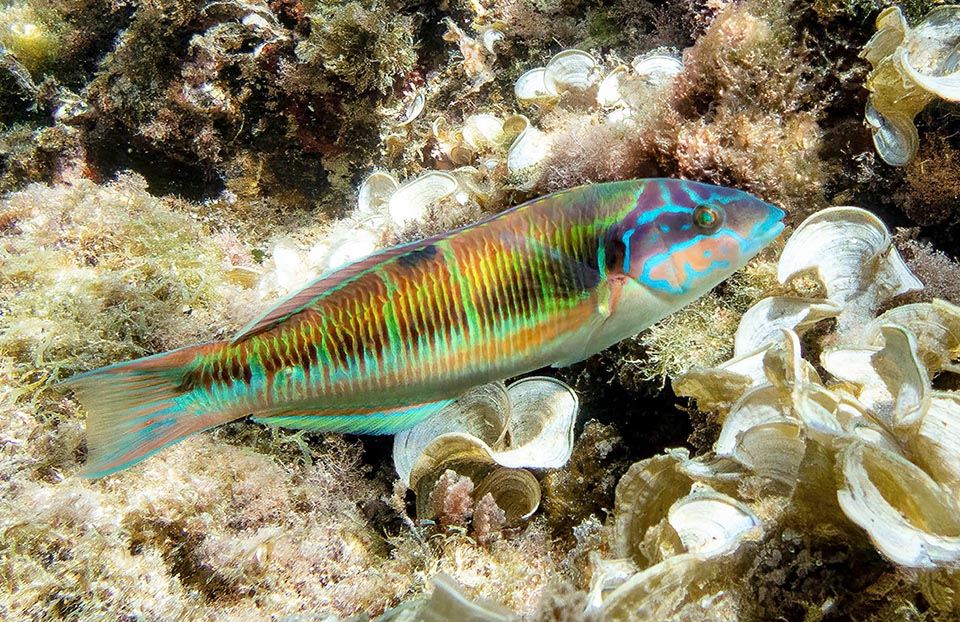
Thus we reach the intermediate livery corresponding to the female one, and being a hermaphrodite and protogynous species, these while growing may turn into males. But it could also be a growing specimen born already male. It is the livery that in the past had originated the Thalassoma pavo variety unimaculata © Jean-Marie Gradot
The ornate wrasse reaches the 18 cm in the females and the 25 cm in the males. The body, fusiform, compressed on the sides; has a long dorsal fin and a much shorter symmetric anal one. The caudal is forked and the pectoral, spatulate, are bigger than the ventral. The head has no scales and the mouth is very small.
Depending on the colour, they were distinguishing three varieties:
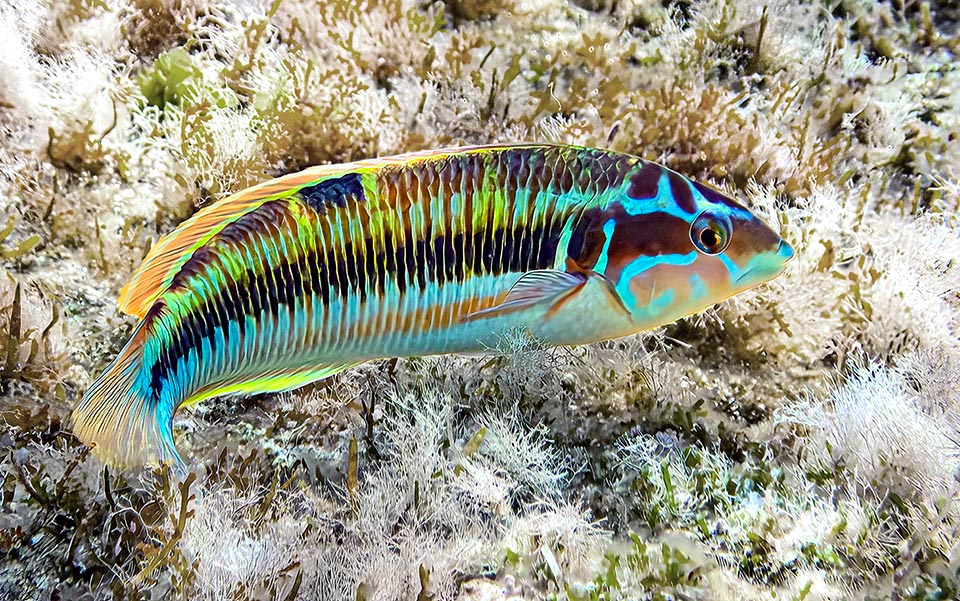
This is an intermediate livery between the two sexes, yore known as Thalassoma pavo variety lineolata © Stefanos Michael
– Thalassoma pavo variety unimaculata Lowe, 1841, more frequent in the cold zones, with a dark dorsal spot, and darker, anyway, in the upper part of the body. Towards the belly, stands out some red on the green-blue vertical structure. The head does not have red zones, but violaceous.
– Thalassoma pavo variety torquata Lowe, 1843, bigger and more frequent in the warm zones. The livery is spectacular with an often very bright contrast between the blue and the bright red of the head. Typical is a vertical blue band edged of red, which separates this zone from the rest of the body, tending to the green with red dots. Reinboth showed later that they were exclusively males.
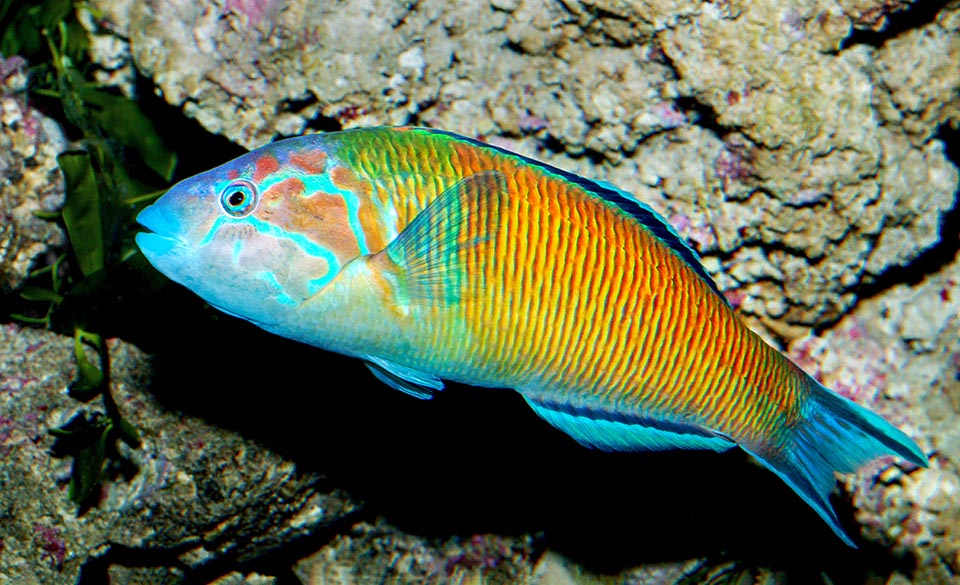
Here we are even closer to male livery. The dorsal black spot has totally disappeared and is visible the typical orange red striation that already fades to greenish near head © Giuseppe Mazza
– Thalassoma pavo variety lineolata Lowe, 1841 which appears as the transition form between the two above.
Nowadays, we talk, like for Coris julis, of a hermaphroditic protogynous species. The females, while growing, should then become males and the temperature should stimulate the change of sex. But the rule is not so rigid. It has been noted that some females do not change sex and that some males are born already as such, but don’t have like the others territorial demands and don’t always show the terminal colouration.
Ethology-Reproductive Biology
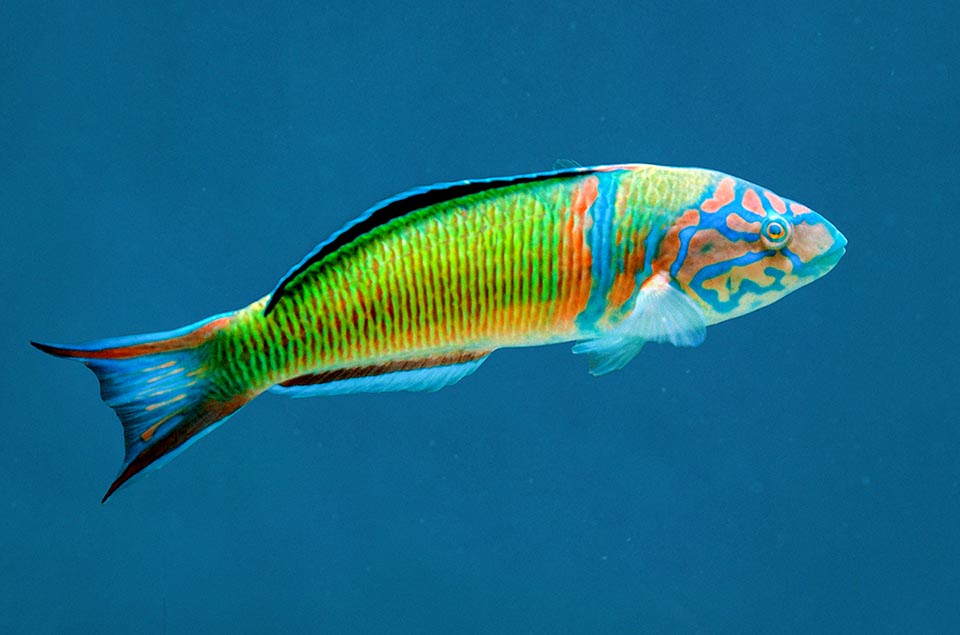
Thus we have reached the male livery, once known as Thalassoma pavo variety torquata. It’s typical the matching of bands and red and blue drawings © Giuseppe Mazza
The ornate wrasse nourishes chiefly of small molluscs, crustaceans but also of eggs. In particular, it surveys the deposition of the Damselfishes (Chromis chromis) and when a nest is discovered on the seabeds immediately some hungry gatherings take form.
When is menaced, for sleeping or during the cold periods, it takes shelter under the sand.
It may be encountered solitary or in small crowds. The reproduction takes place in June-July. The males with the terminal colouration fight among themselves for a rocky zone at about 5 m of depth and the winner, after chasing them away, lets females get in and fecundates the planktonic eggs while swimming. At times the initial males butt in fecundating secretly all what they can.
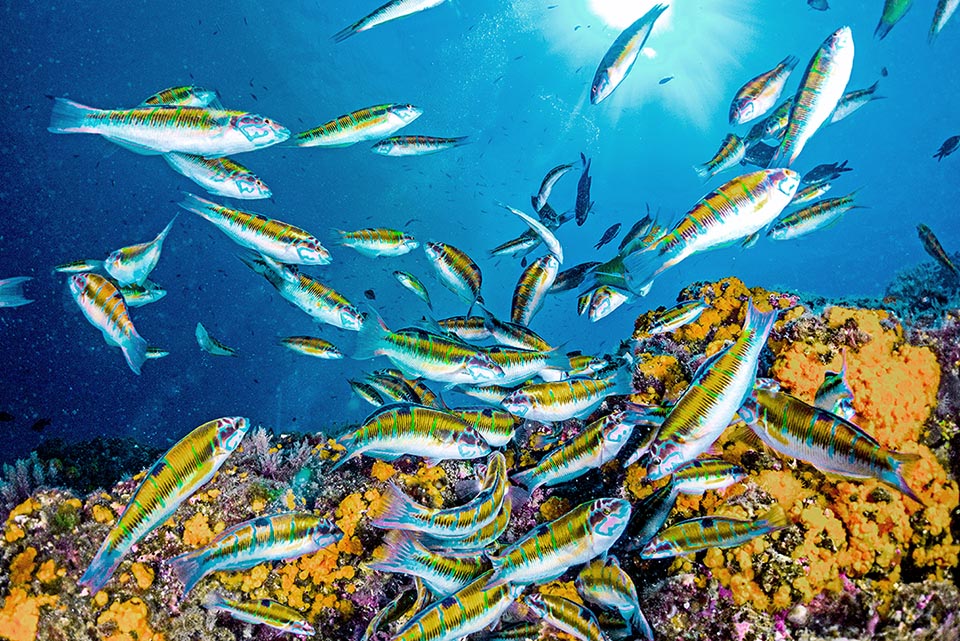
Obviously the females and juveniles are more numerous. Thalassoma pavo feeds on small mollusks and crustaceans, but also on eggs, here found in a Damselfish nest © Rosa Carrapiso
Much in demand for aquariums, the Donzella pavonina is often caught with nets and pots, and in adequately sized tanks it adapts very well to life in captivity.
The resilience of the species is mediocre with a possible doubling of the populations in 1,4-4,4 years, and the fishing vulnerability index is low, marking 21 on a scale of 100.
Thalassoma pavo appears since 2008 in the red list of the endangered species as “Least Concern”.
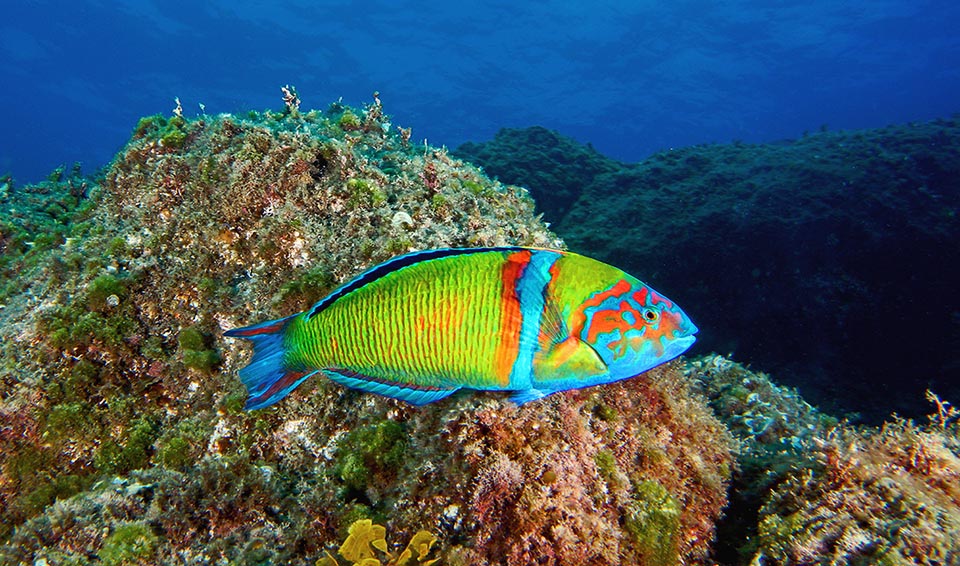
In the mature males, that may get 25 cm long versus the 18 of the females, the colours intensify noticeably and become a flag to get noticed by the competitors and defend the rocky site whosen for mating. Only females are allowed in and fecundating the eggs in mid-water. At times the initial males butt in fecundating secretly all what they can © Jaime Ezequiel Rodríguez Riesco
Synonyms
Chlorichthys pavo Linnaeus, 1758; Julis blochii Valenciennes, 1839; Julis pavo Linnaeus, 1758; Julis squamismarginatus Bowdich, 1825; Julis turcica lemniscata Lowe, 1843; Julis turcica torquata Lowe, 1843; Julis turcicia Risso, 1827; Julis unimaculata Lowe, 1841; Julis unimaculata lineolata Lowe, 1841; Julis unimaculata taeniata Lowe, 1841; Julis vulgaris Valenciennes, 1843; Labrus leo Rafinesque, 1810; Labrus pavo Linnaeus, 1758; Labrus syriacus Bloch & Schneider, 1801; Thalassoma pavo lemniscata Lowe, 1843; Thalassoma pavo taeniata Lowe, 1841; Thalassoma pavo torquata Lowe, 1843; Thalassoma unimaculatum Lowe, 1841.
→ For general information about FISH please click here.
→ For general information about BONY FISH please click here
→ For general information about CARTILAGINOUS FISH please click here.
→ To appreciate the BIODIVERSITY of BONY FISH please click here.
→ To appreciate the BIODIVERSITY of CARTILAGINOUS FISH please click here.
